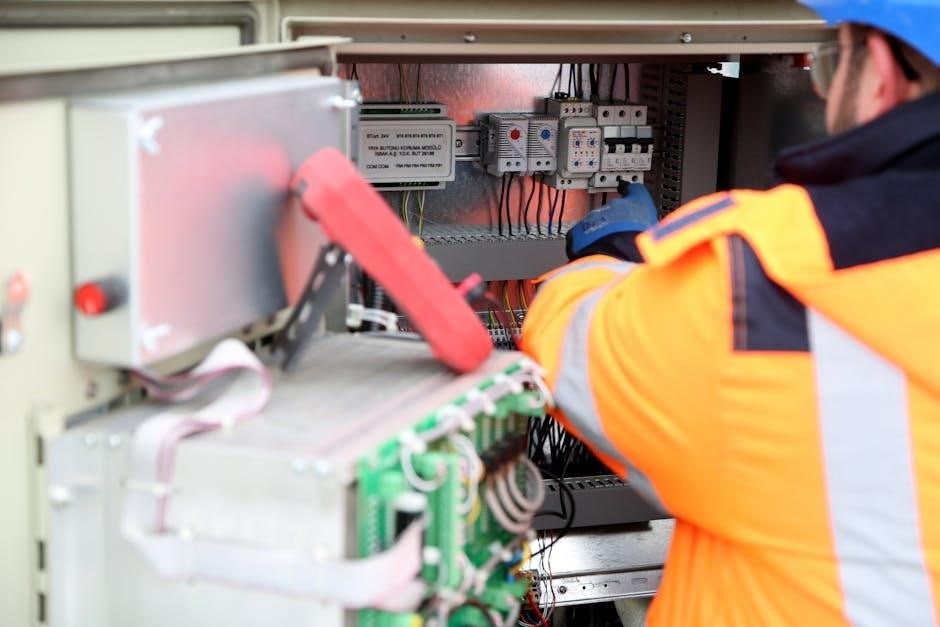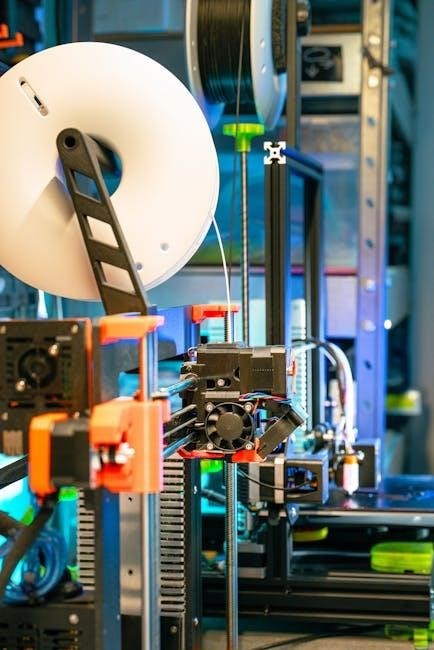
amp research power step troubleshooting guide pdf
Welcome to the AMP Research Power Step Troubleshooting Guide, your comprehensive resource for diagnosing and resolving issues with your power step system․ This guide provides quick solutions and expert advice to restore functionality and ensure optimal performance․
1․1 Overview of the Guide
This guide provides a detailed roadmap for identifying and resolving common issues with the AMP Research Power Step system․ It includes a quick troubleshooting checklist, in-depth diagnostic steps, and maintenance tips to prevent future problems․ The guide is structured to help users systematically address electrical, mechanical, and sensor-related issues․ With clear instructions and visual aids, it empowers vehicle owners and technicians to restore functionality efficiently․ Whether you’re encountering deployment issues, motor noise, or power malfunctions, this resource offers tailored solutions to get your Power Steps working smoothly again․
1․2 Importance of Proper Troubleshooting
Proper troubleshooting is essential to maintain the functionality and longevity of your AMP Research Power Step system․ It helps identify root causes, preventing minor issues from escalating into costly repairs․ Timely diagnosis ensures safety, reliability, and optimal performance․ By addressing problems early, you avoid potential damage to electrical or mechanical components․ Effective troubleshooting also saves time and reduces frustration, keeping your vehicle’s power steps operating smoothly and enhancing your overall ownership experience․ Regular maintenance and quick issue resolution are key to preserving the system’s efficiency and durability over time․

Understanding the AMP Research Power Step System
The AMP Research Power Step system enhances vehicle accessibility with automatic deployment․ It uses motors, actuators, linkages, sensors, and a control module for smooth, reliable operation, integrating seamlessly with your vehicle․
2․1 Key Components and Their Functions
The AMP Research Power Step system comprises essential components that work together seamlessly․ The control module acts as the brain, interpreting signals to control step movement․ The motor and actuator drive the deployment and retraction of the steps, while the wiring harness ensures power and signal transmission․ Door sensors detect door openings to trigger step activation․ Linkages and pivot points enable smooth mechanical movement, and fuses protect the system from electrical overloads․ An override switch, if equipped, allows manual control․ Understanding these components is crucial for effective troubleshooting and maintenance․
2․2 Identifying Your Power Step Model
Accurately identifying your AMP Research Power Step model is essential for effective troubleshooting․ The model number is typically found on a sticker located on the control module or step assembly․ This sticker may also include the manufacturing date and serial number․ If the sticker is missing, refer to your purchase documentation or vehicle paperwork․ Correct model identification ensures access to specific technical resources and replacement parts, streamlining the troubleshooting process and preventing potential complications․ This step is crucial for applying the right solutions to your system․
2․3 The Role of Electrical and Mechanical Components
The AMP Research Power Step system relies on a combination of electrical and mechanical components to function seamlessly․ Electrical components, such as the control module, wiring harness, and sensors, transmit signals and power to operate the system․ Mechanical components, including the motor, actuator, linkages, and pivot points, physically deploy and retract the steps․ Understanding the interaction between these components is vital for diagnosing issues․ The control module acts as the brain, interpreting signals from door sensors to activate the motor․ Proper lubrication and alignment of mechanical parts ensure smooth operation, while intact wiring and connections maintain electrical stability․ This synergy is crucial for reliable performance․

Common Issues with the Power Step System
Common issues include steps not deploying, unusual motor noises, power malfunctions, and electrical faults․ These problems often stem from mechanical or wiring issues․
3․1 Step Not Deploying or Retracting
If your AMP Research Power Step fails to deploy or retract, start by checking the power supply and electrical connections․ Ensure the fuse is intact and wiring is secure․ Inspect for physical obstructions like debris or ice that may block movement․ Test door sensors to confirm they are functioning properly․ If issues persist, examine the motor and actuator for damage or binding․ Lubricate linkages and pivot points to ensure smooth operation․ Addressing these common causes can often resolve deployment or retraction problems effectively․
3․2 Unusual Noises from the Motor
Unusual noises from the AMP Research Power Step motor, such as grinding, clicking, or humming, often indicate mechanical or electrical issues․ These sounds may result from worn or binding components, debris interference, or insufficient lubrication․ To address this, inspect the motor housing for damage, clean away any obstructions, and lubricate moving parts․ Additionally, check the wiring and connections for damage or corrosion, as faulty signals can cause irregular motor operation․ If the issue persists, consult the guide for advanced diagnostic steps to identify and resolve the root cause effectively․
3․3 Power Issues and Electrical Malfunctions
Power issues and electrical malfunctions are common problems with the AMP Research Power Step system․ These issues often stem from faulty wiring, blown fuses, or poor connections․ To diagnose, start by checking the power supply to the control module using a multimeter․ Ensure all ground wires are securely attached and free from corrosion․ Inspect the wiring harness for damage or signs of wear․ If a fuse is blown, replace it with the correct amperage rating․ Addressing these electrical issues promptly can restore functionality and prevent further complications․

Quick Checklist for Troubleshooting
- Verify the power supply and check for blown fuses․
- Inspect for physical obstructions blocking step movement․
- Test door sensors and the override switch functionality․
4․1 Power Source Verification
Start by ensuring the AMP Research Power Step system receives adequate power․ Check the battery terminals for corrosion and clean them if necessary․ Verify the battery voltage using a multimeter; it should read around 12․6 volts for a fully charged battery․ Inspect the ground connections to ensure they’re secure and free from corrosion․ Test the power supply directly at the controller to confirm it’s receiving the correct voltage, as specified in the installation manual․ Addressing power issues first is crucial for proper functionality․
4․2 Inspection for Physical Obstructions
Physically inspect the AMP Research Power Step system for any obstructions preventing proper deployment or retraction․ Check the steps, linkages, and pivot points for debris, ice, or mud accumulation․ Ensure all moving parts are free from blockages․ Lubricate pivot points if necessary to restore smooth operation․ Look for misaligned or bent components that could interfere with functionality․ Addressing physical obstructions early can prevent further damage and ensure reliable performance of your power step system․
4․3 Testing Door Sensors and Override Switch
Test the door sensors to ensure they are activating correctly when doors open or close․ Check the override switch to confirm it is functioning properly and not stuck in the off position․ Verify that the sensors send proper signals to the control module․ If the override switch is engaged, disengage it and test the steps again․ Ensure no debris or obstructions are interfering with sensor operation․ Proper functionality of these components is crucial for reliable power step performance․ Addressing issues here can resolve many common problems effectively․

Detailed Troubleshooting Steps
Follow a systematic approach to identify and resolve issues with your AMP Research Power Step․ This section provides in-depth instructions for diagnosing and fixing problems effectively․
5․1 Checking the Power Supply
Start by ensuring the AMP Research Power Step system receives adequate power․ Inspect battery terminals for corrosion and clean them if necessary․ Verify battery voltage using a multimeter; it should read around 12․6 volts․ Check ground connections for tightness and cleanliness․ Test the power supply to the controller directly, confirming it matches the specified voltage․ Inspect fuses and wiring for damage or corrosion․ Addressing power issues first ensures other components function correctly․ A stable power supply is essential for proper system operation․
5․2 Inspecting Fuses and Wiring
Locate the fuse associated with the AMP Research Power Step system, typically in the vehicle’s fuse box or wiring harness․ Remove and inspect the fuse for damage, such as a broken filament or blackened glass․ If blown, replace it with a fuse of the exact same amperage rating․ Examine the wiring harness for signs of wear, corrosion, or damage․ Use a multimeter to test for continuity and voltage drops․ Clean corroded connectors with a wire brush or electrical cleaner․ Ensure all connections are secure and free from obstruction․ Damaged wiring should be repaired or replaced promptly to prevent further issues․
5․3 Diagnosing Motor and Actuator Problems
Begin by listening for unusual noises when the Power Step operates, such as grinding or clicking sounds, which may indicate motor or actuator issues․ Use a multimeter to test the motor’s electrical connections for proper voltage and continuity․ If the motor fails to respond, disconnect it and test with a direct power source to isolate the problem․ Inspect the actuator arm for obstructions or binding, ensuring it moves smoothly․ Lubricate pivot points if necessary․ If the motor operates independently but not via the system, the issue may lie in the control module or wiring․
5․4 Examining Linkages and Pivot Points
Inspect the linkages and pivot points for obstructions, such as dirt or ice, which may hinder movement․ Lubricate all moving parts to ensure smooth operation․ Check for wear or damage, such as loose joints or corroded components, which can cause binding․ If lubrication doesn’t resolve the issue, inspect for misalignment or excessive play․ Replace any damaged or worn parts to restore proper functionality․ Regular maintenance of these components is crucial for reliable operation and to prevent premature wear․
5․5 Testing Sensors and Control Module
Begin by testing the door sensors to ensure they are signaling correctly when doors open or close․ Use a multimeter to verify sensor voltage and connectivity․ If sensors malfunction, the control module won’t receive the necessary signals to activate the steps․ Next, inspect the control module for proper operation․ Check for firmware updates or reprogramming requirements․ If the module isn’t responding, test its power supply and connections․ A faulty control module may require replacement․ Addressing sensor and module issues ensures proper communication within the system, restoring functionality to your AMP Research Power Step․
5․6 Addressing Issues with the Override Switch
Start by ensuring the override switch is properly engaged and not in the “off” position․ Clean the switch contacts to remove dirt or corrosion․ Inspect the wiring for damage or loose connections, repairing or replacing as needed․ Use a multimeter to test the switch for continuity in different positions․ If the switch malfunctions, replace it․ Ensure the control module recognizes the switch’s input, recalibrating or updating the module if necessary․ Consult the official PDF guide for specific instructions or contact AMP Research support for further assistance․

Tools and Resources Needed
Essential tools include a multimeter, wiring diagram, and torque wrench․ Resources like the official AMP Research PDF guide and technical support hotline are invaluable for troubleshooting․
6․1 Essential Tools for Troubleshooting
To effectively troubleshoot your AMP Research Power Step, gather essential tools like a multimeter, torque wrench, and screwdrivers․ A wiring diagram and the official PDF guide are crucial for diagnosing issues․ Ensure you have a clean workspace and proper lighting․ Additional tools may include a wire brush for cleaning connections and a fuse puller for inspecting electrical components․ Having these tools readily available will streamline the troubleshooting process and help identify problems efficiently․
6․2 Recommended Resources and Documentation
For effective troubleshooting, refer to the official AMP Research Power Step PDF guide, which includes a detailed table of contents, FAQs, and a knowledge base․ The guide provides a quick troubleshooting checklist, flow charts, and step-by-step instructions․ Additional resources include the AMP Research website, technical support hotline (1-888-983-2206), and online forums․ These resources offer expert advice, system operation info, and real-world repair examples․ Utilize these documents and support channels to resolve issues efficiently and ensure your Power Step system functions optimally․

Case Studies and Specific Repair Scenarios
Explore real-world examples of successful repairs, including common issues like step deployment failures and motor malfunctions․ Detailed scenarios provide practical insights into diagnosing and resolving specific problems effectively․
7․1 Resolving Common Power Step Failures
Addressing common failures in the AMP Research Power Step system often involves identifying root causes like faulty motors, obstructed linkages, or electrical issues․ Case studies highlight scenarios where step deployment failed due to debris blockage or wiring defects․ By following the guide’s structured approach, users can systematically diagnose and repair these issues․ Real-world examples demonstrate how inspecting fuses, cleaning sensors, and lubricating pivot points resolved problems efficiently․ These scenarios emphasize the importance of methodical troubleshooting to restore functionality quickly and effectively․
7․2 Real-World Examples of Successful Repairs
Real-world examples highlight successful repairs of AMP Research Power Step systems․ One case involved resolving a non-deploying step by replacing a faulty motor․ Another example fixed unusual noises by lubricating pivot points and replacing worn linkages․ Users also resolved power issues by repairing corroded wiring connections․ These scenarios demonstrate how systematic troubleshooting, as outlined in the guide, leads to effective solutions․ Such examples serve as valuable references for diagnosing and addressing similar issues efficiently, ensuring optimal functionality of the power step system․

Maintenance Tips to Prevent Future Issues
Regular lubrication of moving parts and scheduled inspections of electrical components can prevent future issues․ Ensure steps are free from debris and wiring connections are secure for optimal performance․
8․1 Regular Lubrication of Moving Parts
Regular lubrication of moving parts is essential to ensure smooth operation and prevent wear․ Apply a high-quality silicone-based lubricant to hinges, linkages, and pivot points every six months or after exposure to harsh conditions․ Clean surfaces before lubricating to remove dirt or debris․ This maintenance step prevents rust, reduces friction, and ensures the Power Step system functions reliably․ Proper lubrication also helps avoid binding or seizing, which can lead to motor strain and premature wear․ Consistent care extends the lifespan of your AMP Research Power Step system․
8․2 Scheduled Inspection of Electrical Components
Regularly inspecting electrical components is crucial for maintaining your AMP Research Power Step system․ Check wiring for signs of wear, damage, or corrosion, and ensure all connections are secure․ Inspect fuses and replace any that are blown or damaged․ Use a multimeter to verify proper voltage to the motor and control module․ Clean corroded connectors with a wire brush or electrical cleaner․ Schedule these inspections every 6 months or after extreme weather exposure to prevent electrical failures and ensure reliable operation․ Always consult your manual for specific guidelines and safety precautions․

Accessing the Official AMP Research Power Step PDF Guide
Visit the official AMP Research website to download the Power Step Troubleshooting Guide PDF․ Navigate to the “Support” or “Downloads” section for easy access to the free guide․
9․1 Where to Find the PDF Document
The official AMP Research Power Step Troubleshooting Guide PDF is available for download on the AMP Research website․ Navigate to the “Support” or “Downloads” section․ Click on the link labeled “Troubleshooting Guide” or “Power Step Manual” to access the PDF․ Ensure you select the correct model-specific document․ Once downloaded, save the file for easy reference․ The guide includes detailed instructions, diagrams, and troubleshooting steps to help resolve common issues with your Power Step system effectively․
9․2 Navigating the Guide’s Table of Contents
The AMP Research Power Step Troubleshooting Guide is organized into a clear table of contents for easy navigation․ The document begins with a quick troubleshooting guide, followed by frequently asked questions, system operation details, and a knowledge base․ Users can also reference a troubleshooting flow chart to diagnose issues systematically․ Additional sections include notes on the flow chart and contact information for technical support․ This structured approach ensures users can quickly locate relevant information to resolve Power Step issues efficiently․
This guide provides a comprehensive approach to diagnosing and resolving AMP Research Power Step issues․ By following these steps, users can restore functionality and maintain optimal performance effectively․
10․1 Summary of Key Troubleshooting Steps
Start by verifying the power supply and inspecting fuses and wiring for damage․ Test door sensors and the override switch to ensure proper function․ Check for physical obstructions and lubricate moving parts to maintain smooth operation․ Diagnose motor and actuator issues, and address any electrical malfunctions․ Refer to the official AMP Research Power Step PDF guide for detailed instructions and diagrams to resolve common problems efficiently․ Regular maintenance and systematic troubleshooting will help restore functionality and prevent future issues․
10․2 Encouragement to Utilize the Guide Effectively
By following this guide, you’ll gain the confidence and knowledge to diagnose and resolve issues efficiently․ The structured approach ensures clarity, empowering you to address problems proactively․ Regularly referring to the guide will help maintain your Power Step system’s optimal performance․ Use the troubleshooting steps, maintenance tips, and resources provided to maximize functionality and reliability․ Embrace this comprehensive tool to enhance your problem-solving skills and keep your AMP Research Power Step operating smoothly for years to come․

Additional Resources and Support
For further assistance, contact AMP Research technical support at 1-888-983-2206 or explore online forums and communities for additional troubleshooting resources and peer advice․
11․1 Contacting AMP Research Technical Support
For personalized assistance, contact AMP Research Technical Support at 1-888-983-2206, available Monday through Friday from 8:00 AM to 5:00 PM PST․ Before reaching out, ensure you have your Power Step model number and a detailed description of the issue․ This helps the team provide accurate and efficient solutions․ Their experienced technicians are equipped to address a wide range of concerns, from electrical malfunctions to mechanical issues, ensuring your Power Step system operates flawlessly․
11․2 Online Communities and Forums for Further Assistance
Online communities and forums are invaluable resources for additional support with your AMP Research Power Step system․ Platforms like enthusiast forums and specialized automotive groups offer real-world solutions, user experiences, and expert advice․ Engage with active communities to share concerns, gather insights, and access troubleshooting tips from experienced users and technicians․ These forums often provide detailed discussions on common issues, DIY repairs, and product updates, ensuring you have a wealth of knowledge at your fingertips to resolve complex problems effectively․